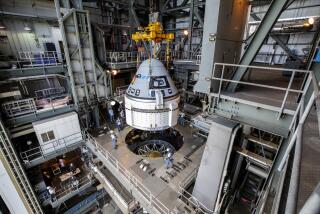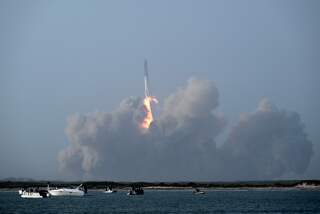NASA Denies Claims It’s Shading Shuttle Problems
- Share via
NASA officials denied Friday that the agency was playing down the risks of foam and ice debris damage in its haste to launch the space shuttle again, as alleged in leaked internal documents.
“We’re not doing anything that tries to hide the risks,” said N. Wayne Hale Jr., deputy manager of the space shuttle program.
Judging the risks of space flight is “a messy business,” he said. “There has been a lot of debate.... We are listening to dissenting opinions.”
He emphasized that the shuttle Discovery -- scheduled to launch May 22 -- would not take off until it was deemed safe.
The New York Times reported Friday that documents it received from NASA employees showed the space agency had loosened its standards for what could be considered acceptable risk.
The documents concerned the risks from debris damage -- the same kind of hazard that led to the breakup and disintegration of the Columbia orbiter Feb. 1, 2003, killing all seven astronauts aboard.
The article said the documents showed that NASA’s flight certification process had relaxed the traditional “worst-on-worst” analysis of disaster to a best estimate of “actual flight conditions.”
Hale disputed that NASA was so determined to get the shuttle flying again that it was prepared to cut corners and manipulate its analysis.
“I never want to go to another astronaut’s memorial service,” Hale said. “There will be no corners cut on my watch.”
One of the key recommendations from the board that investigated the Columbia accident was that NASA must solve problems with debris-shedding and ice formation on the external tank before returning the shuttle to service. A piece of foam that came off the external fuel tank was blamed as the cause of the Columbia accident.
Since the accident, engineers have redesigned the fuel tank to eliminate the need for thick chunks of foam on the bipod fitting.
But eliminating or mitigating all 177 sources of foam-shedding has proven more difficult.
John Muratore, manager of systems engineering and integration for the shuttle program, denied tinkering with mathematical models to make the risk of foam and ice damage more acceptable.
Muratore said he felt justified not using the traditional worst-on-worst measurement of risk, saying that was intended for use on conventional aircraft under design. The shuttles are different because they have been flying for years and are uniquely complex systems.
He said a worst-on-worst risk assessment of a simple trip to the airport would have to incorporate the possibility of driving 90 mph, suffering a blown tire, winding up in the hospital while still needing to make the flight. It would be impractical, he said, to use such a high standard when considering the risks of flying the shuttle.
Test results are still being analyzed and no final decisions have been made about whether to clear the Discovery for flight. That won’t happen until flight readiness reviews are completed about two weeks before the launch. All tests and analyses will be presented to top NASA managers, including the newly installed administrator, Michael D. Griffin.
Hale said one of the most troubling things about the leaked documents was the employees’ fear of retribution if their names were known. One of the harshest criticisms of the Columbia investigation board was that NASA’s internal culture squelched debate and made lower-ranking employees fear speaking up.
NASA has repeatedly argued that it is doing everything it can to change the perception that dissent is unwelcome.
“We’re trying to convince people to share dissenting opinions,” Hale said.
Hale expressed no resentment that the documents had been leaked.
“Nothing could be further from the truth,” he said. “These people want us to fly safely in space.”
More to Read
Sign up for Essential California
The most important California stories and recommendations in your inbox every morning.
You may occasionally receive promotional content from the Los Angeles Times.










